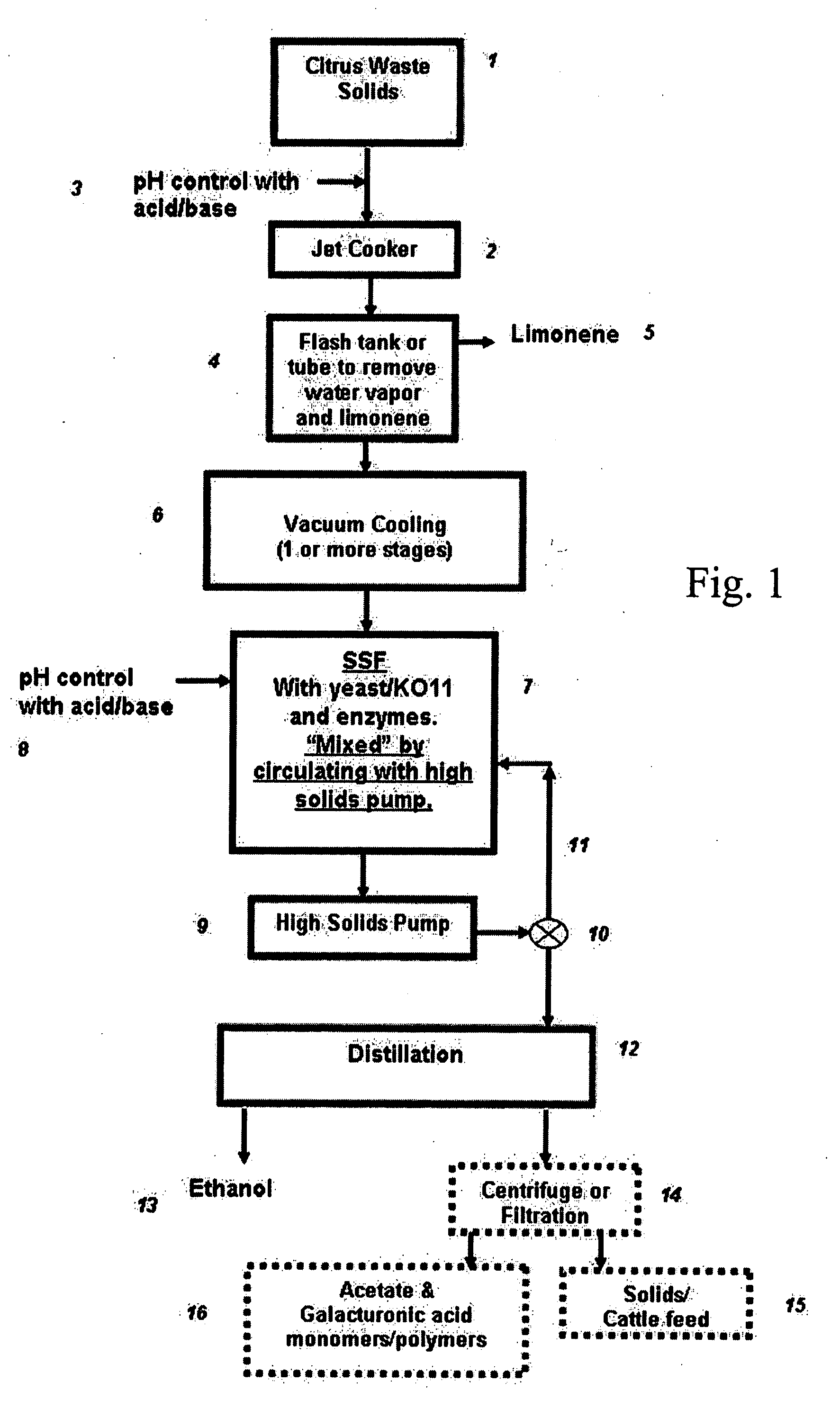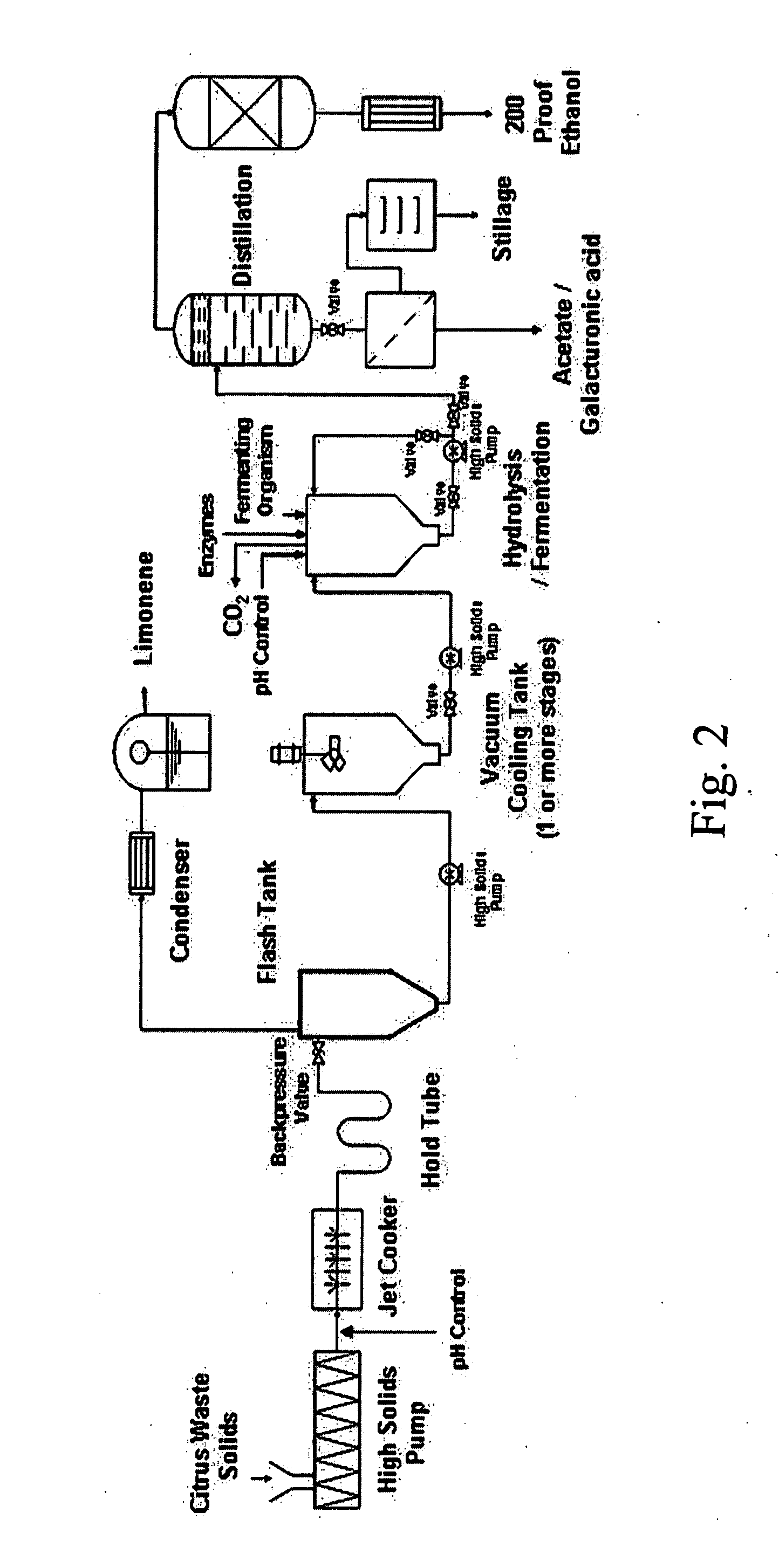Currently, the generation of solid citrus waste, consisting primarily of peel, membranes, and seeds, which result from the
processing of
citrus fruit for juice, is an environmental problem.
The problem exists particularly in areas where the bulk of citrus is grown to produce juice, such as in the State of Florida and the country of Brazil.
Traditionally, such solid citrus waste has been converted into cattle feed which typically does not have sufficient value to cover the production and transportation costs associated therewith.
A further drawback of converting current citrus waste into cattle feed is that the waste contains a high amount of d(+)-
limonene (generally referred to simply as limonene).
Volatilization of the limonene during the
drying process causes
air pollution to the extent that limonene vapors are exhausted into the
atmosphere at the
processing plants, this happens because it would require very expensive equipment to trap the limonene from the drier exhaust.
Although citrus waste materials do create an environmental problem, these materials are rich in
pectin and other polysaccharides that can be hydrolyzed into sugars for use in the production of ethanol.
A major problem that prevents processing citrus waste into ethanol using microorganisms is limonene.
Yet another problem is the release of fermentable sugars from citrus waste at concentrations as high as possible.
Dilution of solid citrus waste with large amounts of water often currently used to aid processing and to accommodate equipment limitations is thus not practical for ethanol production from this material.
Citrus waste needs to be processed at
high concentration of solids which makes handling and processing of the material very difficult; in addition, waste tissues need to be broken down to release soluble sugars and complex carbohydrates (e.g.,
pectin,
cellulose,
hemicellulose) must be hydrolyzed to release additional sugars and maximize ethanol production.
However, the prior art has not provided an integrated
system or method which can process solid citrus waste with minimal
dilution by water and which addresses all of the problems outlined above.
The process disclosed by King does not teach removal of limonene from solid citrus waste and is unsuitable for processing of such material since the equipment utilized by King is incapable of handling solid citrus waste.
In addition the process disclosed by King is very inefficient in that it utilizes less than one half of the soluble fermentable sugars present in citrus waste as only those fermentable sugars present in the liquid portion that can be pressed from the waste are used and the press liquor yield is approximately one half of the total liquid contained in the citrus waste.
None of the fermentable sugars in the complex carbohydrates are utilized by King because these carbohydrates are not hydrolyzed and released and made available for fermentation.
However, the process disclosed by Pavilon can only utilize and process the whole citrus waste
biomass as a
slurry in water; about one-fourth to one-third of a gallon of water (approximately 2-3 pounds) is added for each pound of peel.
However,
distillation costs to recover ethanol from such fermented mash with less than 4% ethanol by volume rise exponentially and quickly becomes prohibitively expensive (The
Alcohol Textbook, 2003, K. A. Jacques, T. P. Lyons, D. R. Kelsall, Ed., Notingham University Press, Notingham, UK, p 326.).
The method described by Pavilon requires slurries and cannot
handle solids or highly viscous materials.
However,
citric acid is not present in the waste as a
free acid but as salts and the concentration of catalytic
hydronium ions is too low (pH=4-5) for efficient
hydrolysis of these complex polysaccharides; thus only incomplete
hydrolysis is possible.
Pavilon does not disclose removal of limonene prior to fermentation and instead relies on
dilution of citrus waste with water to decrease limonene concentration in the fermentation step.
While the
screw press reactor may be suitable for processing of fibrous
vegetable matter, it is not suitable for processing of steam (vapor) treated citrus processing waste since such waste becomes extremely soft upon
steaming and passes easily through screen openings even under very low pressure.
Screen presses or similar filtering devices are thus unsuitable for
dewatering of
heat treated, wet highly viscous citrus waste.
In addition,
screw press devices are complex, consume large amounts of energy for pressing, and have high maintenance requirements.
The process described by Pavilon claims to utilize all the sugars in the
waste stream but requires addition of excessive amounts of water to allow handling of the citrus waste and decrease inhibition by limonene, resulting in a fermented product with a dilute
ethanol content under 1.5% which makes it substantially more costly to recover the ethanol.
While the method described herein is unique in converting solid
citrus juice processing waste which is high in
pectin and other complex carbohydrates, making it difficult to
handle, it can also be used to convert other processing waste materials with chemical compositions similar to citrus waste, such as
sugar beet
bagasse, containing large amounts of pectin and which are also difficult to
handle in processing without adding large volumes of water.
 Login to View More
Login to View More 


